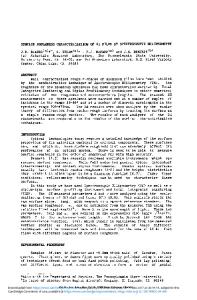Nondestructive Depth-Profiling of Multilayer Structures by Spectroscopic Ellipsometry
- PDF / 1,379,806 Bytes
- 3 Pages / 604.8 x 806.4 pts Page_size
- 63 Downloads / 366 Views
-r Spectroscopic Ellipsometer The a u t o m a t e d s p e c t r o s c o p i c ellipJ someter that has been built in our laboratory is based on the design of Aspnes and Studna. 3 A schematic diagram of the instrument is shown in Figure 1. It is basically a r o t a t i n g a n a l y z e r e l l i p s o m e t e r ^ operated by an on-line Apple computer, and it has spectroscopic scanning capabil•• ity. Plane polarized monochromatic light is allowed to be incident on the sample at t a chosen angle of incidence. The characteristics of the elliptically polarized re"* fleeted light is a n a l y z e d by a r o t a t i n g analyzer. As Budde 4 has shown, Fourier analysis of the detector output in a rotatx ing analyzer ellipsometer yields the desired ellipsometric parameters A and ^ -i characterizing the material under study. Aspnes has pointed out that with proper *• design, alignment and operation, the precision attained is very high, and accuracy *" of the data is also as high as that attainable with null ellipsometers. The results of our o w n studies confirm these concluy sions. Such measurements are carried out at a n u m b e r of d i s c r e t e w a v e l e n g t h s -*, (~100) distributed uniformly in the UVvisible-near IR spectral range. •4 •* * ^ ^.\
Modeling An IBM 370/3080 computer is then used for analyzing the above raw ellipsometric data by systematically screening a number of realistic multilayer models (to mimic the experimental sample). The spectra of the ellipsometric parameters A and ^ for each of these models are evaluated using exact equations of ellipsometry. If a particular layer of the model is a mixture of two components, such as crystalline silicon (cSi) and amorphous silicon (a-Si) [to simul a t e a d a m a g e d l a y e r on c-Si], or of amorphous silicon and voids [to simulate a microrough surface over a substrate of a-
Si], then the dielectric function of this composite layer is first computed with the help of Bruggeman's effective m e d i u m theory 5 for multicomponent media, and then used to evaluate ei and e2, real and imaginary parts of the effective or pseudodielectric constant, for the model. Least squares regression analysis (LRA)6 is then used to minimize the difference between the calculated and experimental data by adjusting the model parameters, and finally to obtain the results in terms of bestfit m o d e l p a r a m e t e r s a n d t h e i r 90% confidence limits as well as the unbiased estimator of the mean square deviation. 6,7 Since t h e n u m b e r of u n k n o w n m o d e l parameters is usually 1-6, and since these p a r a m e t e r s are b e i n g e v a l u a t e d from about 200 independent experimental readings corresponding to measurements at ~100 wavelengths, it is evident that this method of data analysis will yield statistically meaningful values for the m o d e l parameters. Ion Implanted Semiconductors A m o n g the various multilayer structures studied by SE to date, the case of self-ion implanted silicon crystals provides an excellent e x a m p l e of the r e s o
Data Loading...










